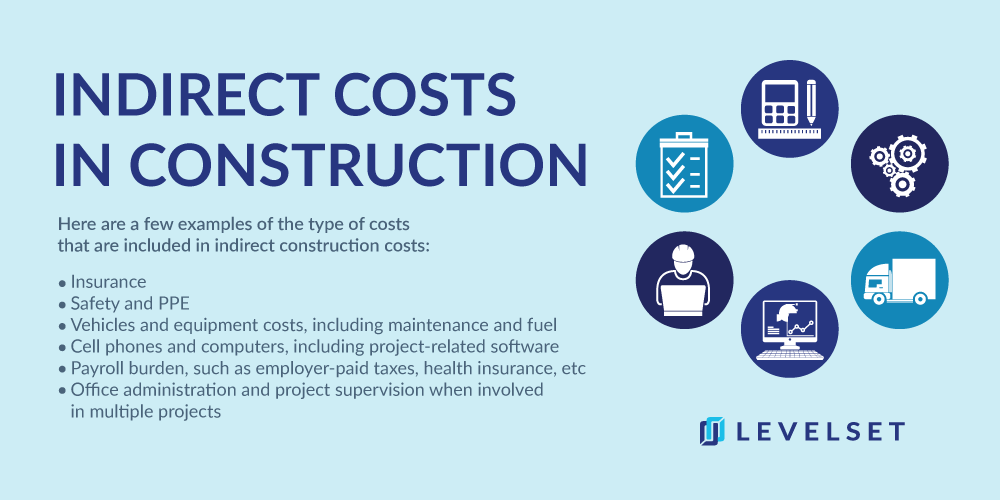
There are lots of costs to track in construction projects — materials, labor, subcontractors, equipment, and other expenses. Some of these costs are directly related to specific projects, while others affect multiple projects at the same time. Indirect costs in construction can affect your bottom line. If you aren’t tracking them and allocating them to each project, your estimated profit calculations may be incorrect.
Deep dive – Construction Costs: 3 Ways Contractors Can Deal with Rising Prices
Defining indirect costs in construction
The easiest way to describe indirect costs is to describe what they are not. Direct costs are those costs that are specific to a construction project. They include materials, on-site labor, and subcontractors. Administrative costs are costs incurred in doing business and have nothing to do with projects. These include office rent, supplies, and taxes, and tend to remain the same no matter how much work you’re doing.
Indirect costs are what’s left: They include costs that are not specific to any particular project, but are required as part of the construction. They usually benefit multiple projects at the same time and tend to vary depending on the volume of work.

Examples of indirect costs
Here are a few examples of the type of costs that are included in indirect construction costs:
- Vehicles and equipment costs, including maintenance and fuel
- Cell phones and computers, including project-related software
- Insurance
- Payroll burden, such as employer-paid taxes, health insurance, etc.
- Office administration and project supervision when involved in multiple projects
- Safety and PPE
How to calculate and allocate indirect costs
Although indirect costs don’t relate to a specific project, they should be equally distributed to all projects and included in overhead expenses. These costs affect the gross profit on projects, and should be taken into consideration when calculating the overall profit.
There are several methods to allocate indirect costs to projects. Companies should use the method that most closely matches their business type and that most accurately distributes costs to the projects.
How the costs are allocated isn’t as important as that it’s done consistently over time. Costs should be allocated on a regular basis, either monthly or quarterly, depending on the length of your projects.
Labor hours
Contractors who provide mostly labor may want to allocate their indirect costs based on the number of labor hours in a period. To do this, run reports showing the total indirect costs and the total labor hours for the period, then divide the hours into the costs to determine the cost per hour. You can then allocate this cost for every hour of work performed on each project.
Labor costs
This is another way for contractors who provide mostly labor to allocate their indirect labor costs. To calculate the distribution, divide total labor costs into total indirect costs to get the percentage of indirect costs. Then, take the percentage and multiply it by the labor costs for each project. This is the additional amount that should be allocated to each project.
Material costs
For contractors or suppliers who provide mostly materials, basing the allocation on material costs may be more accurate. The math is similar to that used for labor costs — just substitute material costs.
Equipment hours
If your company allocates costs by equipment, then this could be the calculation that you want to use. It’s similar to the labor hours calculation — just substitute equipment hours for the labor hours.
Direct costs
Some contractors may choose to allocate their indirect costs based on the total costs of each project. The calculation is similar to those based on costs above, except overall direct project costs are included instead of specific cost types.
Getting paid for indirect costs
In order to ensure that you are getting paid for these indirect costs, which affect your overall job cost totals, you need to include them in your bids. First, however, you have to know how much indirect costs are costing you. The first step is to start tracking them. You can do this by setting up general ledger accounts to track the various indirect costs that you have. Once you have about three months’ worth of costs tracked, then you can start allocating the total to the active projects in that timeframe.
After you have done your first allocation of indirect costs, you should be able to allocate costs to your proposals going forward. It’s important to note that you’ll need to recalculate your indirect cost allocation each time you allocate costs, as indirect costs vary depending on how busy you are.
To ensure that you receive payment for these costs, always protect your payment rights: File the correct notices, and, if necessary, a mechanics lien. The costs associated with collecting payments are considered direct job costs since they are attributable to a specific project.
How to reduce indirect costs
Since indirect costs reduce your gross profit, it’s desirable to keep them as low as possible.
This can be difficult when you’re busy, because these costs go up as you take on more projects. Lowering costs overall is better for your business, as long as you are able to do the work in a quality manner.
Here are some ways you can lower your overhead costs, including indirect costs:
- Improve staff efficiency through software and workflow improvements
- Shop around for project supplies and other indirect costs to get the best deal
- Use project management software and apps to streamline your operations
Protect payments to cover indirect costs in construction
Indirect costs can significantly impact the profit margin of your projects. Tracking them and allocating them correctly to your project estimates and bids is important to maintain profitability.
Once you know what your indirect costs are, you can make decisions to help lower them, increasing your profit. As always, protecting payments is the best way to ensure you get paid for these costs.